Characteristics of Dissolved Organic Matter Impacted by Different Land Use in Haihe River Watershed, China
Abstract
1. Introduction
2. Materials and Methods
2.1. Site Description
2.2. Sample Collection and Water Quality Testing
2.3. UV-Vis Absorption Spectra and Fluorescence Spectroscopy Analysis
2.4. Land Use Classification and Statistics
3. Results
3.1. Characteristics of Water Quality Parameters
3.2. Seasonal Variation of DOC and CDOM Absorption Coefficients
3.3. Fluorescence Spectroscopy Analysis by PARAFAC Modelling
3.4. RDA Models: Environmental Predictors versus the Quantity and Quality of DOM
4. Discussion
4.1. Source Analysis of DOM
4.2. Spatial and Temporal Factors Influencing DOC Concentrations
4.3. The Impact of Land-Use Types on DOM in Watershed
5. Conclusions
Author Contributions
Funding
Institutional Review Board Statement
Informed Consent Statement
Conflicts of Interest
References
- Brezonik, P.L.; Olmanson, L.G.; Finlay, J.C.; Bauer, M.E. Factors affecting the measurement of CDOM by remote sensing of optically complex inland waters. Remote Sens. Environ. 2015, 157, 199–215. [Google Scholar] [CrossRef]
- Park, J.H.; Kalbitz, K.; Matzner, E. Resource control on the production of dissolved organic carbon and nitrogen in a deciduous forest floor. Soil Boil. Biochem. 2002, 34, 813–822. [Google Scholar] [CrossRef]
- Wang, M.; Chen, Y.G. Generation and characterization of DOM in wastewater treatment processes. Chemosphere 2018, 201, 96–109. [Google Scholar] [CrossRef] [PubMed]
- Coble, P.G. Characterization of marine and terrestrial DOM in seawater using excitation-emission matrix spectroscopy. Mar. Chem. 1996, 51, 325–346. [Google Scholar] [CrossRef]
- Mostofa, K.M.G.; Jie, Y.; Sakugawa, H.; Liu, C.Q. Equal Treatment of Different EEM Data on PARAFAC Modeling Produces Artifact Fluorescent Components That Have Misleading Biogeochemical Consequences. Environ. Sci. Technol. 2019, 53, 561–563. [Google Scholar] [CrossRef]
- Singh, S.; D’Sa, E.J.; Swenson, E.M. Chromophoric dissolved organic matter (CDOM) variability in Barataria Basin using excitation-emission matrix (EEM) fluorescence and parallel factor analysis (PARAFAC). Sci. Total Environ. 2010, 408, 3211–3222. [Google Scholar] [CrossRef]
- Niu, C.; Zhang, Y.; Zhu, G.; Wang, M.; Zhou, Y.; Liu, X. Comparison of Optical Properties of DOM and CDOM in Lake Tianmuhu Catchment. Res. Environ. Sci. 2014, 27, 998–1007. [Google Scholar]
- Tao, P.R.; Jin, M.; Yu, X.B.; Yu, J.; Zheng, R.Y. Spatiotemporal variations in chromophoric dissolved organic matter (CDOM) in a mixed land-use river: Implications for surface water restoration. J. Environ. Manag. 2021, 277, 111498. [Google Scholar] [CrossRef]
- Borisover, M.; Laor, Y.; Parparov, A.; Bukhanovsky, N.; Lado, M. Spatial and seasonal patterns of fluorescent organic matter in Lake Kinneret (Sea of Galilee) and its catchment basin. Water Res. 2009, 43, 3104–3116. [Google Scholar] [CrossRef]
- Goldman, J.H.; Rounds, S.A.; Needoba, J.A. Applications of Fluorescence Spectroscopy for Predicting Percent Wastewater in an Urban Stream. Environ. Sci. Technol. 2012, 46, 4374–4381. [Google Scholar] [CrossRef]
- Stedmon, C.A.; Bro, R. Characterizing dissolved organic matter fluorescence with parallel factor analysis: A tutorial. Limnol. Oceanogr.-Meth. 2008, 6, 572–579. [Google Scholar] [CrossRef]
- Hudson, N.; Baker, A.; Reynolds, D. Fluorescence analysis of dissolved organic matter in natural, waste and polluted waters—A review. River Res. Appl. 2007, 23, 631–649. [Google Scholar] [CrossRef]
- Vera, M.; Cruz, S.; Boleda, M.R.; Mesa, J.; Martin-Alonso, J.; Casas, S.; Gibert, O.; Cortina, J.L. Fluorescence spectroscopy and parallel factor analysis as a dissolved organic monitoring tool to assess treatment performance in drinking water trains. Sci. Total Environ. 2017, 584-585, 1212–1220. [Google Scholar] [CrossRef] [PubMed]
- Fellman, J.B.; D’Amore, D.V.; Hood, E.; Boone, R.D. Fluorescence characteristics and biodegradability of dissolved organic matter in forest and wetland soils from coastal temperate watersheds in southeast Alaska. Biogeochemistry 2008, 88, 169–184. [Google Scholar] [CrossRef]
- Mattsson, T.; Kortelainen, P.; Raike, A. Export of DOM from boreal catchments: Impacts of land use cover and climate. Biogeochemistry 2005, 76, 373–394. [Google Scholar] [CrossRef]
- Hosen, J.D.; Armstrong, A.W.; Palmer, M.A. Dissolved organic matter variations in coastal plain wetland watersheds: The integrated role of hydrological connectivity, land use, and seasonality. Hydrol. Process. 2018, 32, 1664–1681. [Google Scholar] [CrossRef]
- Kalbitz, K.; Solinger, S.; Park, J.H.; Michalzik, B.; Matzner, E. Controls on the dynamics of dissolved organic matter in soils: A review. Soil Sci. 2000, 165, 277–304. [Google Scholar] [CrossRef]
- Wilson, H.F.; Xenopoulos, M.A. Ecosystem and seasonal control of stream dissolved organic carbon along a gradient of land use. Ecosystems 2008, 11, 555–568. [Google Scholar] [CrossRef]
- Spencer, R.G.M.; Aiken, G.R.; Wickland, K.P.; Striegl, R.G.; Hernes, P.J. Seasonal and spatial variability in dissolved organic matter quantity and composition from the Yukon River basin, Alaska. Glob. Biogeochem. Cycles 2008, 22, GB4002. [Google Scholar] [CrossRef]
- Hu, Y.; Lu, Y.; Edmonds, J.W.; Liu, C.; Wang, S.; Das, O.; Liu, J.; Zheng, C. Hydrological and land use control of watershed exports of dissolved organic matter in a large arid river basin in northwestern China. J. Geophys. Res. Biogeosci. 2016, 121, 466–478. [Google Scholar] [CrossRef]
- Xiao, M.; Chen, Z.; Zhang, Y.; Wen, Y.; Shang, L.; Zhong, J. The Optical Characterization and Distribution of Dissolved Organic Matter in Water Regimes of Qilian Mountains Watershed. Int. J. Environ. Res. Public Health 2022, 19, 59. [Google Scholar] [CrossRef] [PubMed]
- Song, X.Y.; Zhao, Y.; Zhang, L.Y.; Xie, X.Y.; Wu, J.Q.; Wei, Z.M.; Yang, H.Y.; Zhang, S.B.; Song, C.H.; Jia, L.M. Photodegradation, bacterial metabolism and photosynthesis drive the dissolved organic matter cycle in the Heilongjiang River. Chemosphere 2022, 295, 133923. [Google Scholar] [CrossRef] [PubMed]
- Zeng, S.Y.; Dong, X.; Chen, J.N. Toxicity assessment of metals in sediment from the lower reaches of the Haihe River Basin in China. Int. J. Sediment Res. 2013, 28, 172–181. [Google Scholar] [CrossRef]
- Suzuki, Y.; Tanoue, E.; Ito, H. A high-temperature catalytic oxidation method for the determination of dissolved organic carbon in seawater: Analysis and improvement. Deep-Sea Res. 1992, 39, 185–198. [Google Scholar] [CrossRef]
- Helms, J.R.; Stubbins, A.; Ritchie, J.D.; Minor, E.C.; Kieber, D.J.; Mopper, K. Absorption spectral slopes and slope ratios as indicators of molecular weight, source, and photobleaching of chromophoric dissolved organic matter. Limnol. Oceanogr. 2008, 53, 955–969. [Google Scholar] [CrossRef]
- Dilling, J.; Kaiser, K. Estimation of the hydrophobic fraction of dissolved organic matter in water samples using UV photometry. Water Res. 2002, 36, 5037–5044. [Google Scholar] [CrossRef]
- Weishaar, J.L.; Aiken, G.R.; Bergamaschi, B.A.; Fram, M.S.; Fujii, R.; Mopper, K. Evaluation of specific ultraviolet absorbance as an indicator of the chemical composition and reactivity of dissolved organic carbon. Environ. Sci. Technol. 2003, 37, 4702–4708. [Google Scholar] [CrossRef]
- Barreto, S.R.G.; Nozaki, J.; Barreto, W.J. Origin of dissolved organic carbon studied by UV-vis spectroscopy. Acta Hydroch. Hydrob. 2004, 31, 513–518. [Google Scholar] [CrossRef]
- Yan, M.Q.; Fu, Q.W.; Li, D.C.; Gao, G.F.; Wang, D.S. Study of the pH influence on the optical properties of dissolved organic matter using fluorescence excitation–emission matrix and parallel factor analysis. J. Lumin. 2013, 142, 103–109. [Google Scholar] [CrossRef]
- McKnight, D.M.; Boyer, E.W.; Westerhoff, P.K.; Doran, P.T.; Kulbe, T.; Andersen, D.T. Spectrofluorometric characterization of dissolved organic matter for indication of precursor organic material and aromaticity. Limnol. Oceanogr. 2001, 46, 38–48. [Google Scholar] [CrossRef]
- Tedetti, M.; Cuet, P.; Guigue, C.; Goutx, M. Characterization of dissolved organic matter in a coral reef ecosystem subjected to anthropogenic pressures (La Reunion Island, Indian Ocean) using multi-dimensional fluorescence spectroscopy. Sci. Total Environ. 2011, 409, 2198–2210. [Google Scholar] [CrossRef] [PubMed]
- Murphy, K.R.; Butler, K.D.; Spencer, R.G.M.; Stedmon, C.A.; Boehme, J.R.; Aiken, G.R. Measurement of Dissolved Organic Matter Fluorescence in Aquatic Environments: An Interlaboratory Comparison. Environ. Sci. Technol. 2010, 44, 9405–9412. [Google Scholar] [CrossRef] [PubMed]
- Feisal, N.A.S.; Kamaludin, N.H.; Sani, M.F.A.; Ahmad, D.K.A.; Ahmad, M.A.; Razak, N.F.A.; Ibrahim, T.N.B.T. Anthropogenic disturbance of aquatic biodiversity and water quality of an urban river in Penang, Malaysia. Water Sci. Eng. 2022, in press. [Google Scholar] [CrossRef]
- Zhao, Y.; Song, K.S.; Li, S.J.; Ma, J.H.; Wen, Z.D. Characterization of CDOM from urban waters in Northern-Northeastern China using excitation-emission matrix fluorescence and parallel factor analysis. Environ. Sci. Pollut. Res. 2016, 23, 15381–15394. [Google Scholar] [CrossRef] [PubMed]
- Stedmon, C.A.; Markager, S. Resolving the variability in dissolved organic matter fluorescence in a temperate estuary and its catchment using PARAFAC analysis. Limnol. Oceanogr. 2005, 50, 686–697. [Google Scholar] [CrossRef]
- Williams, C.J.; Yamashita, Y.; Wilson, H.F.; Jaffe, R.; Xenopoulos, M.A. Unraveling the role of land use and microbial activity in shaping dissolved organic matter characteristics in stream ecosystems. Limnol. Oceanogr. 2010, 55, 1159–1171. [Google Scholar] [CrossRef]
- Yao, X.; Zhang, Y.L.; Zhu, G.W.; Qin, B.Q.; Feng, L.Q.; Cai, L.L.; Gao, G.A. Resolving the variability of CDOM fluorescence to differentiate the sources and fate of DOM in Lake Taihu and its tributaries. Chemosphere 2011, 82, 145–155. [Google Scholar] [CrossRef]
- Liao, Z.L.; Chu, J.Y.; Luo, C.J.; Chen, H. Revealing characteristics of dissolved organic matter in urban runoff at three typical regions via optical indices and molecular composition. J. Environ. Sci. 2021, 108, 8–21. [Google Scholar] [CrossRef]
- Shao, T.T.; Wang, T. Effects of land use on the characteristics and composition of fluvial chromophoric dissolved organic matter (CDOM) in the Yiluo River watershed, China. Ecol. Indic. 2020, 114, 106332. [Google Scholar] [CrossRef]
- Rochelle-Newall, E.J.; Fisher, T.R. Chromophoric dissolved organic matter and dissolved organic carbon in Chesapeake Bay. Mar. Chem. 2002, 77, 23–41. [Google Scholar] [CrossRef]
- Xia, F.; Liu, Z.H.; Zhao, M.; Li, Q.; Li, D.; Cao, W.F.; Zeng, C.; Hu, Y.D.; Chen, B.; Bao, Q.; et al. High stability of autochthonous dissolved organic matter in karst aquatic ecosystems: Evidence from fluorescence. Water Res. 2022, 220, 118723. [Google Scholar] [CrossRef] [PubMed]
- Kelsey, S.A.; Grottoli, A.G.; Bauer, J.E.; Lorenz, K.; Lal, R.; Matsui, Y.; Huey-Sanders, T.M. Effects of agricultural and tillage practices on isotopic signatures and fluxes of organic and inorganic carbon in headwater streams. Aquat. Sci. 2020, 82, 23. [Google Scholar] [CrossRef]
- Sun, H.; Han, J.; Li, D.; Lu, X.; Zhang, H.; Zhao, W. Organic carbon transport in the Songhua River, NE China: Influence of land use. Hydrol. Process. 2017, 31, 2062–2075. [Google Scholar] [CrossRef]
- Gucker, B.; Silva, R.; Graeber, D.; Monteiro, J.A.F.; Boechat, I.G. Urbanization and agriculture increase exports and differentially alter elemental stoichiometry of dissolved organic matter (DOM) from tropical catchments. Sci. Total Environ. 2016, 550, 785–792. [Google Scholar] [CrossRef] [PubMed]
- Huang, Q.; Liu, L.Z.; Huang, J.C.; Chi, D.W.; Devlin, A.T.; Wu, H.W. Seasonal dynamics of chromophoric dissolved organic matter in Poyang Lake, the largest freshwater lake in China. J. Hydrol. 2022, 605, 127298. [Google Scholar] [CrossRef]
- Gu, N.; Song, Q.; Yang, X.; Yu, X.; Li, X.; Li, G. Fluorescence characteristics and biodegradability of dissolved organic matter (DOM) leached from non-point sources in southeastern China. Environ. Pollut. 2020, 258, 113807. [Google Scholar] [CrossRef]
- Wilson, H.F.; Xenopoulos, M.A. Effects of agricultural land use on the composition of fluvial dissolved organic matter. Nat. Geosci. 2009, 2, 37–41. [Google Scholar] [CrossRef]
- Singh, S.; Inamdar, S.; Mitchell, M.; McHale, P. Seasonal pattern of dissolved organic matter (DOM) in watershed sources: Influence of hydrologic flow paths and autumn leaf fall. Biogeochemistry 2014, 118, 321–337. [Google Scholar] [CrossRef]
- Coward, E.K.; Ohno, T.; Sparks, D.L. Direct evidence for temporal molecular fractionation of dissolved organic matter at the iron oxyhydroxide interface. Environ. Sci. Technol. 2019, 53, 642–650. [Google Scholar] [CrossRef]
- Leinemann, T.; Preusser, S.; Mikutta, R.; Kalbitz, K.; Cerli, C.; Hoschen, C.; Mueller, C.W.; Kandeler, E.; Guggenberger, G. Multiple exchange processes on mineral surfaces control the transport of dissolved organic matter through soil profiles. Soil Biol. Biochem. 2018, 118, 79–90. [Google Scholar] [CrossRef]
- Graeber, D.; Gelbrecht, J.; Pusch, M.T.; Anlanger, C.; von Schiller, D. Agriculture has changed the amount and composition of dissolved organic matter in Central European headwater streams. Sci. Total Environ. 2012, 438, 435–446. [Google Scholar] [CrossRef]
- Shi, Y.; Zhang, L.Q.; Li, Y.P.; Zhou, L.; Zhou, Y.Q.; Zhang, Y.L.; Huang, C.C.; Li, H.P.; Zhu, G.W. Influence of land use and rainfall on the optical properties of dissolved organic matter in a key drinking water reservoir in China. Sci. Total Environ. 2020, 699, 134301. [Google Scholar] [CrossRef] [PubMed]
- Santos, R.S.; Weismeier, M.; Oliveira, D.M.S.; Locatelli, J.L.; Barreto, M.S.C.; Dematte, J.A.M.; Cerri, C.E.P. Conversion of Brazilian savannah to agricultural land affects quantity and quality of labile soil organic matter. Geoderma 2022, 406, 115509. [Google Scholar] [CrossRef]
- Griffin, C.G.; Frey, K.E.; Rogan, J.; Holmes, R.M. Spatial and interannual variability of dissolved organic matter in the Kolyma River, East Siberia, observed using satellite imagery. J. Geopgys. Res. -Biogeosci. 2011, 116, G03018. [Google Scholar] [CrossRef]
- Six, J.; Feller, C.; Denef, K.; Ogle, S.M.; de Moraes Sa, J.C.; Albrecht, A. Soil organic matter, biota and aggregation in temperate and tropical soils-effects of no-tillage. Agronomie 2002, 22, 755–775. [Google Scholar] [CrossRef]
- Lee, G.F.; Jones-Lee, A.; Hall, W.L. Environmental Impact of Fertilizer on Soil and Water; Hall, W.L., Robarge, W.P., Eds.; American Chemical Society: Washington, DC, USA, 2004; pp. 207–219. [Google Scholar]
- Ishii, S.K.L.; Boyer, T.H. Behavior of Reoccurring PARAFAC Components in Fluorescent Dissolved Organic Matter in Natural and Engineered Systems: A Critical Review. Environ. Sci. Technol. 2012, 46, 2006–2017. [Google Scholar] [CrossRef]
- Garcia, R.D.; del Carmen Diéguez, M.; Gerea, M.; Garcia, P.E.; Reissig, M. Characterization and reactivity continuum of dissolved organic matter in forested headwater catchments of Andean Patagonia. Freshw. Biol. 2018, 63, 1049–1062. [Google Scholar] [CrossRef]
- Lambert, T.; Bouillon, S.; Darchambeau, F.; Morana, C.; Roland, F.A.E.; Descy, J.-P.; Borges, A.V. Effects of human land use on the terrestrial and aquatic sources of fluvial organic matter in a temperate river basin (The Meuse River, Belgium). Biogeochemistry 2017, 136, 19–211. [Google Scholar] [CrossRef]
- Curra-Sanchez, E.D.; Lara, C.; Dottone, M.C.; Nimptsch, J.; Aguayo, M.; Broitman, B.R.; Saldias, G.S.; Vargas, C.A. Contrasting land-uses in two small river basins impact the colored dissolved organic matter concentration and carbonate system along a river-coastal ocean continuum. Sci. Total Environ. 2022, 806, 150435. [Google Scholar] [CrossRef]
- Lu, Y.H.; Bauer, J.E.; Canuel, E.A.; Yamashita, Y.; Chambers, R.M.; Jaffe, R. Photochemical and microbial alteration of dissolved organic matter in temperate headwater streams associated with different land use. J. Geophys. Res.-Biogeosci. 2013, 118, 566–580. [Google Scholar] [CrossRef]
- Rabbi, S.F.; Linser, R.; Hook, J.M.; Wilson, B.R.; Lockwood, P.V.; Daniel, H.; Young, I.M. Characterization of soil organic matter in aggregates and size-density fractions by solid state 13C CPMAS NMR spectroscopy. Commun. Soil Sci. Plant Anal. 2014, 45, 1523–1537. [Google Scholar] [CrossRef]
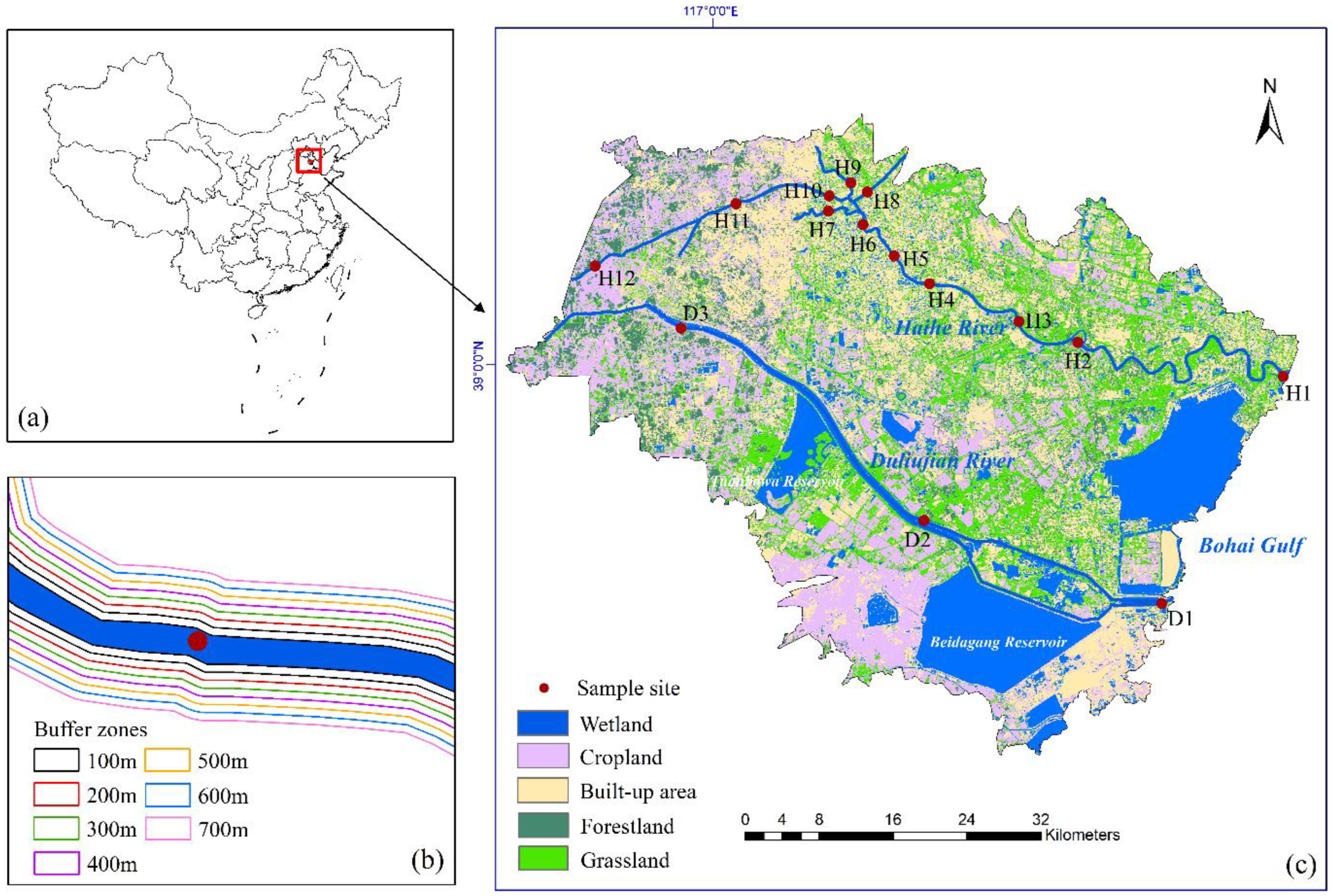
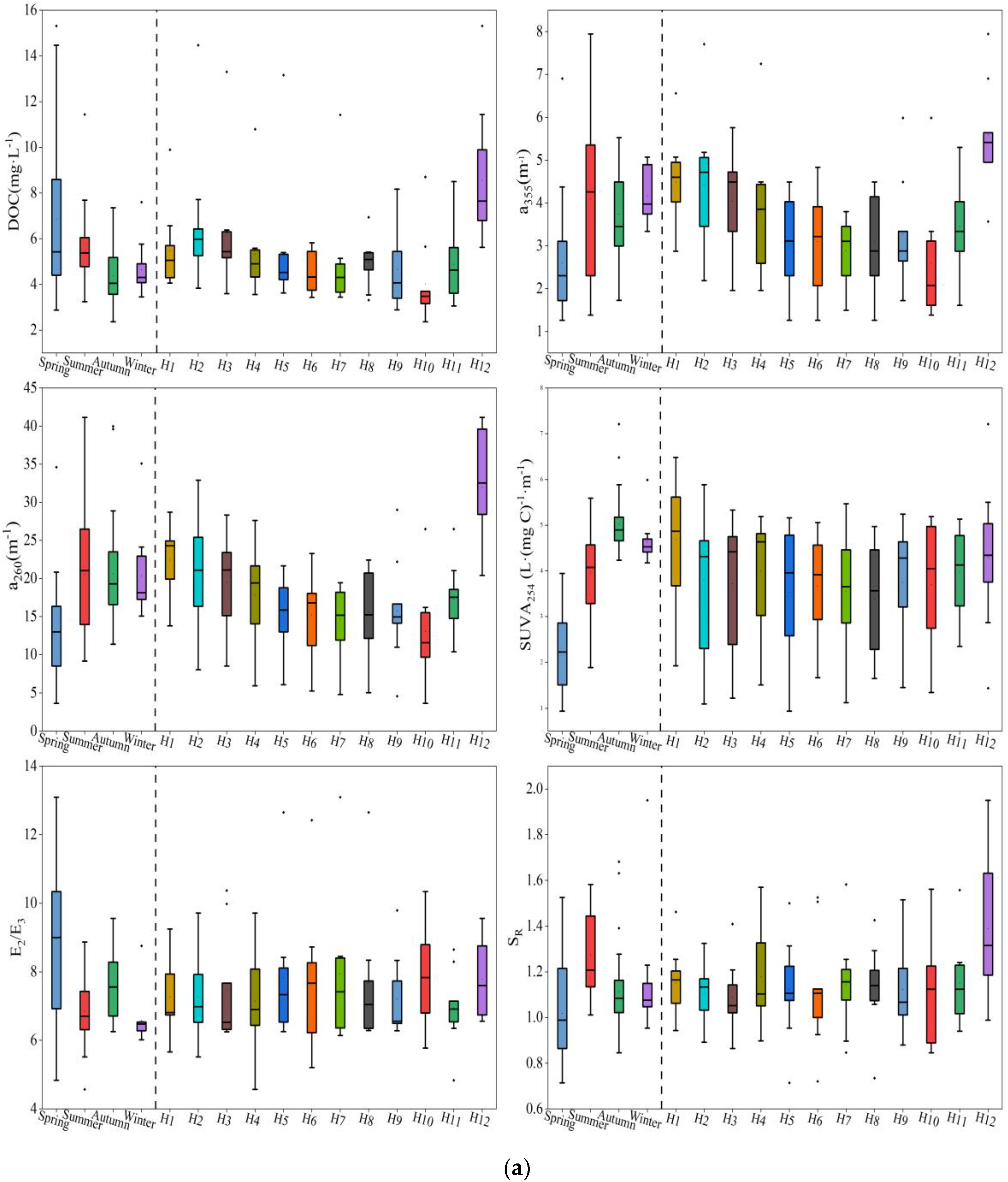
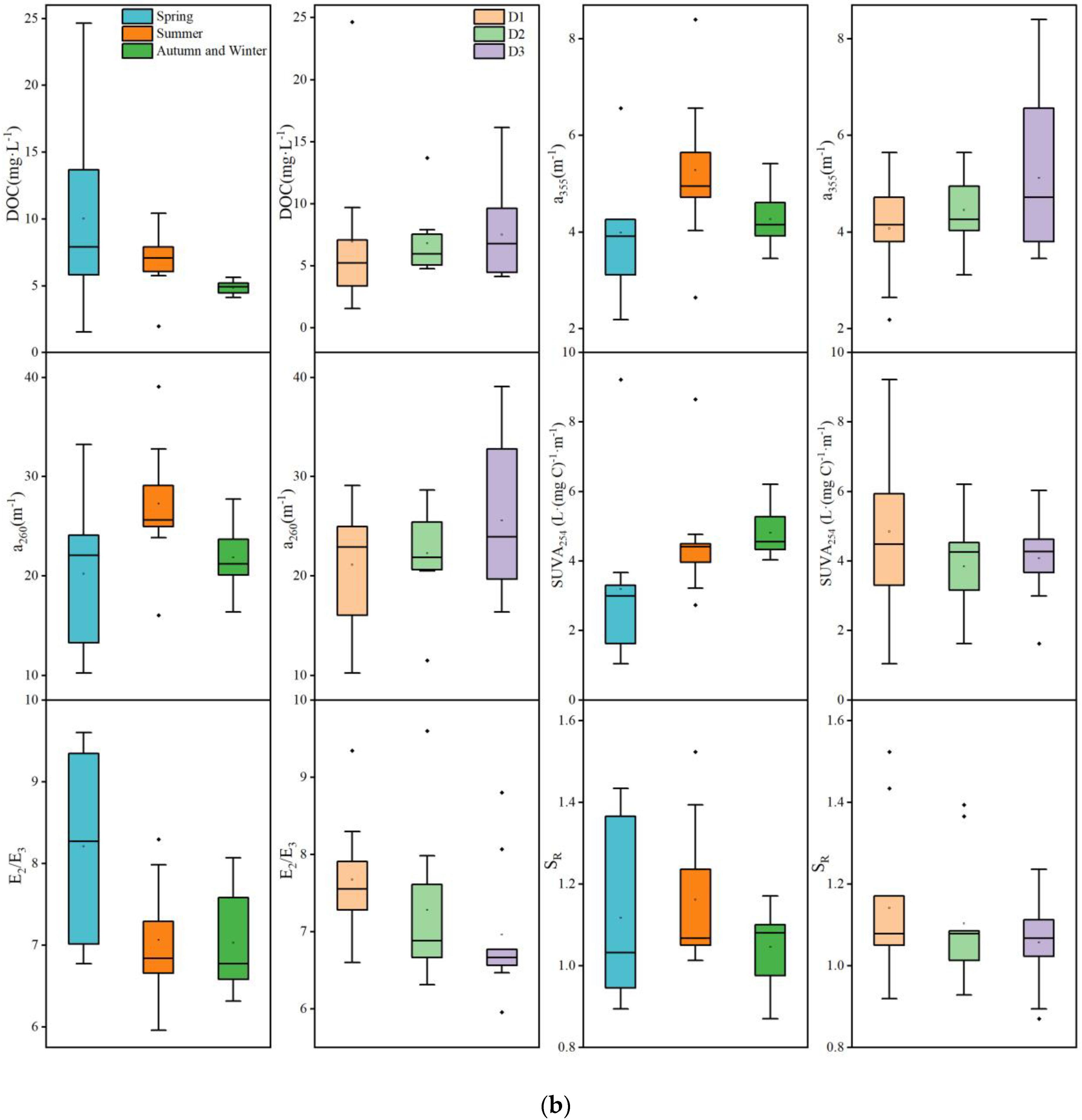


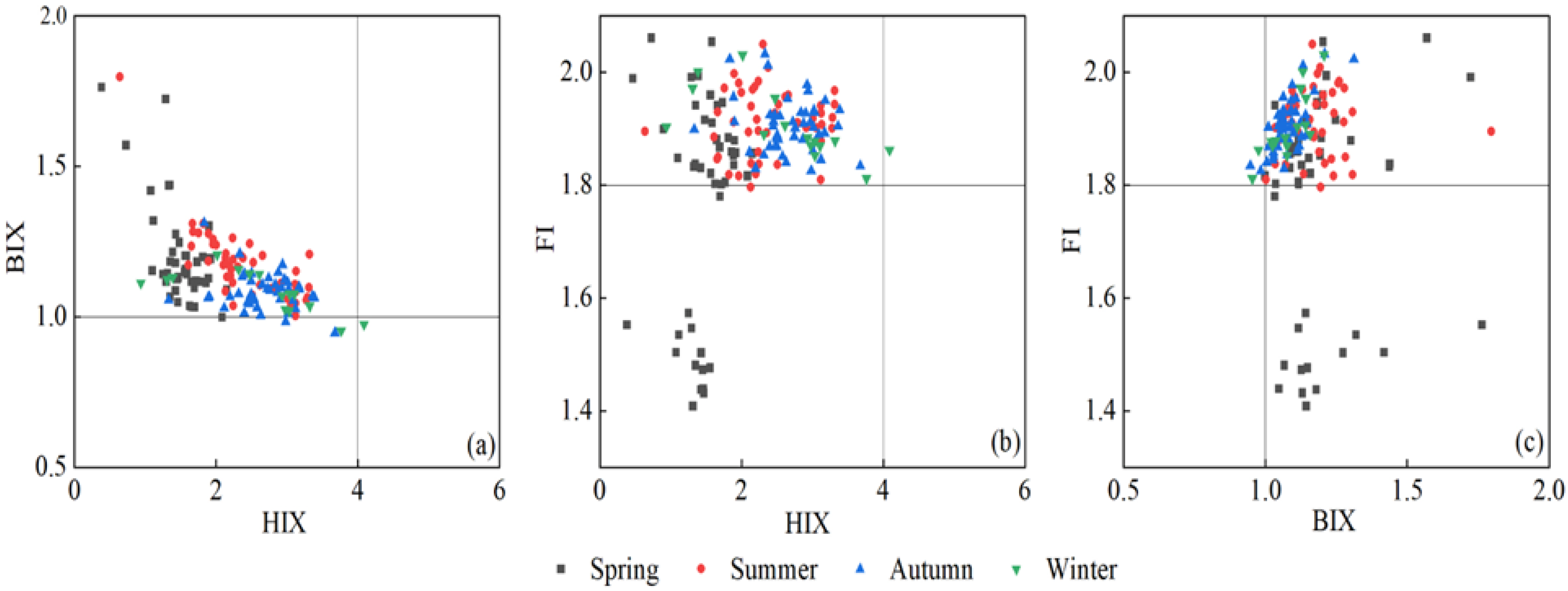
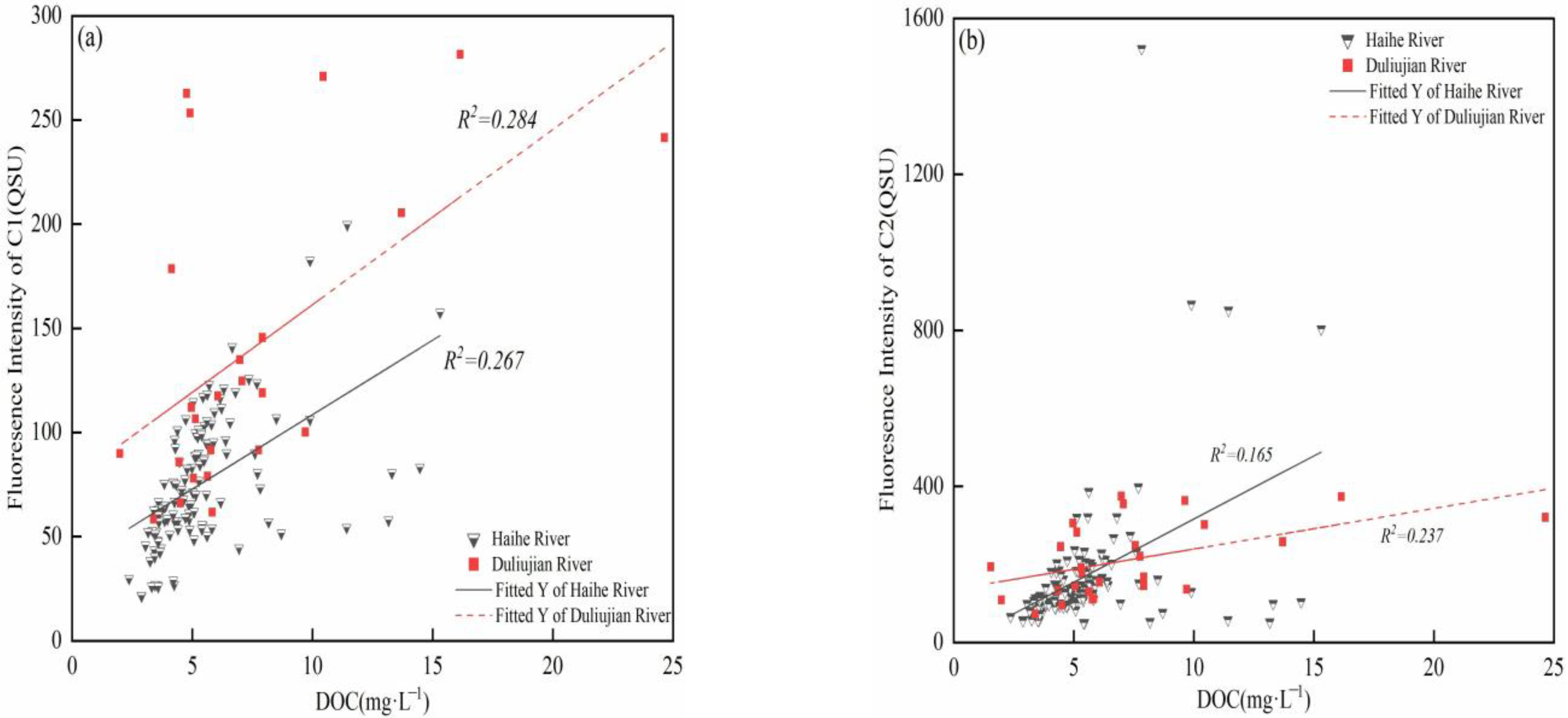
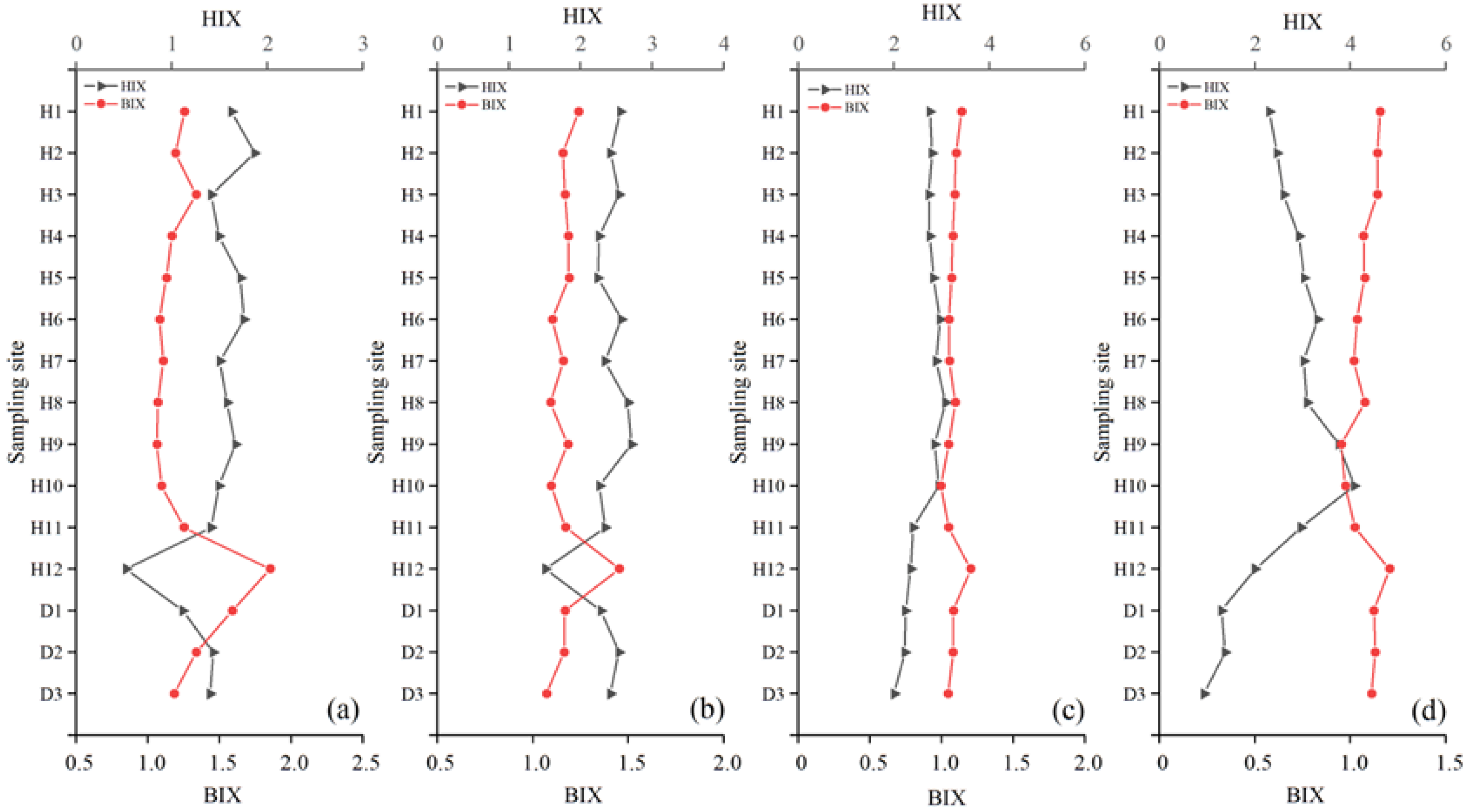
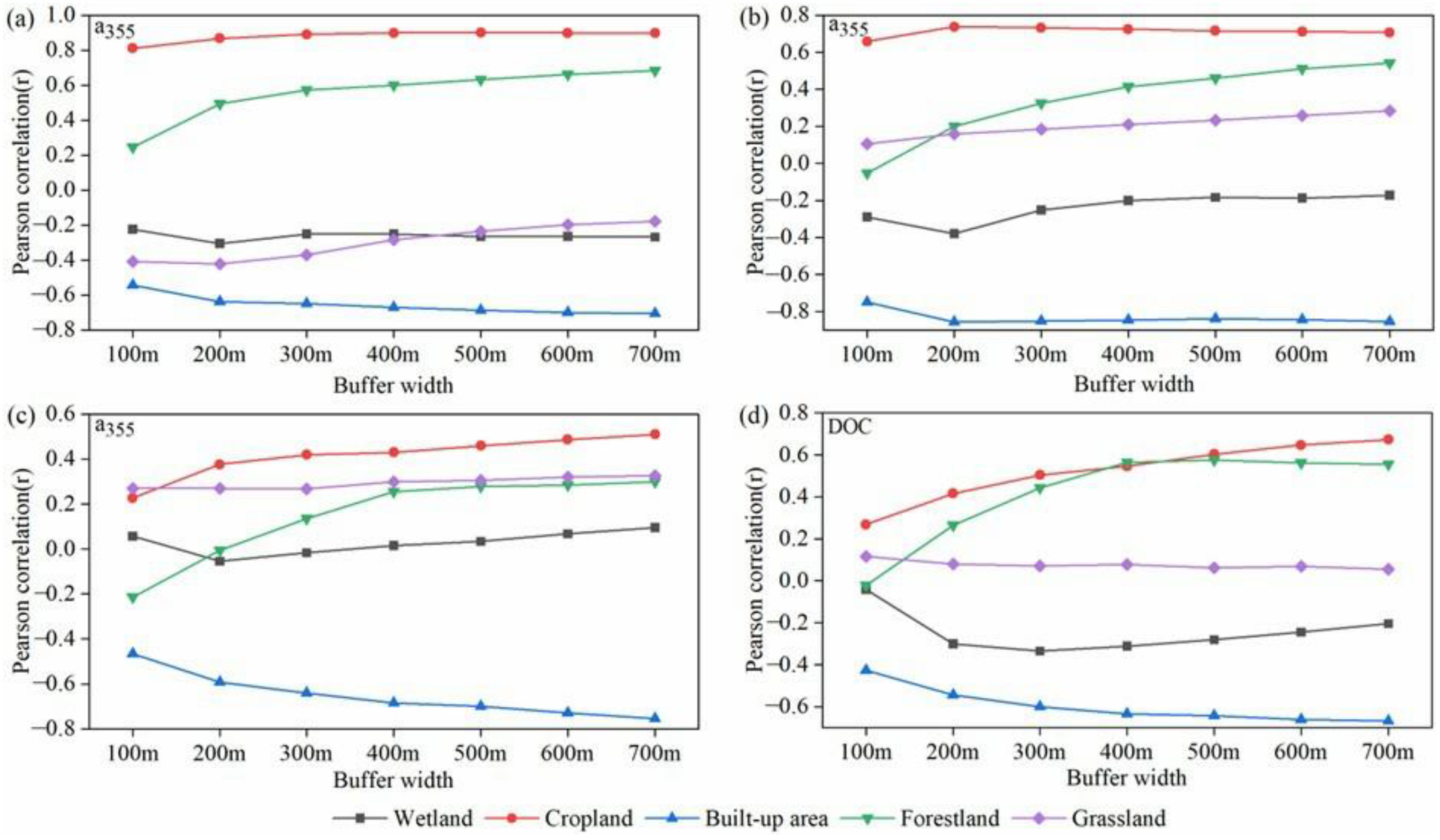

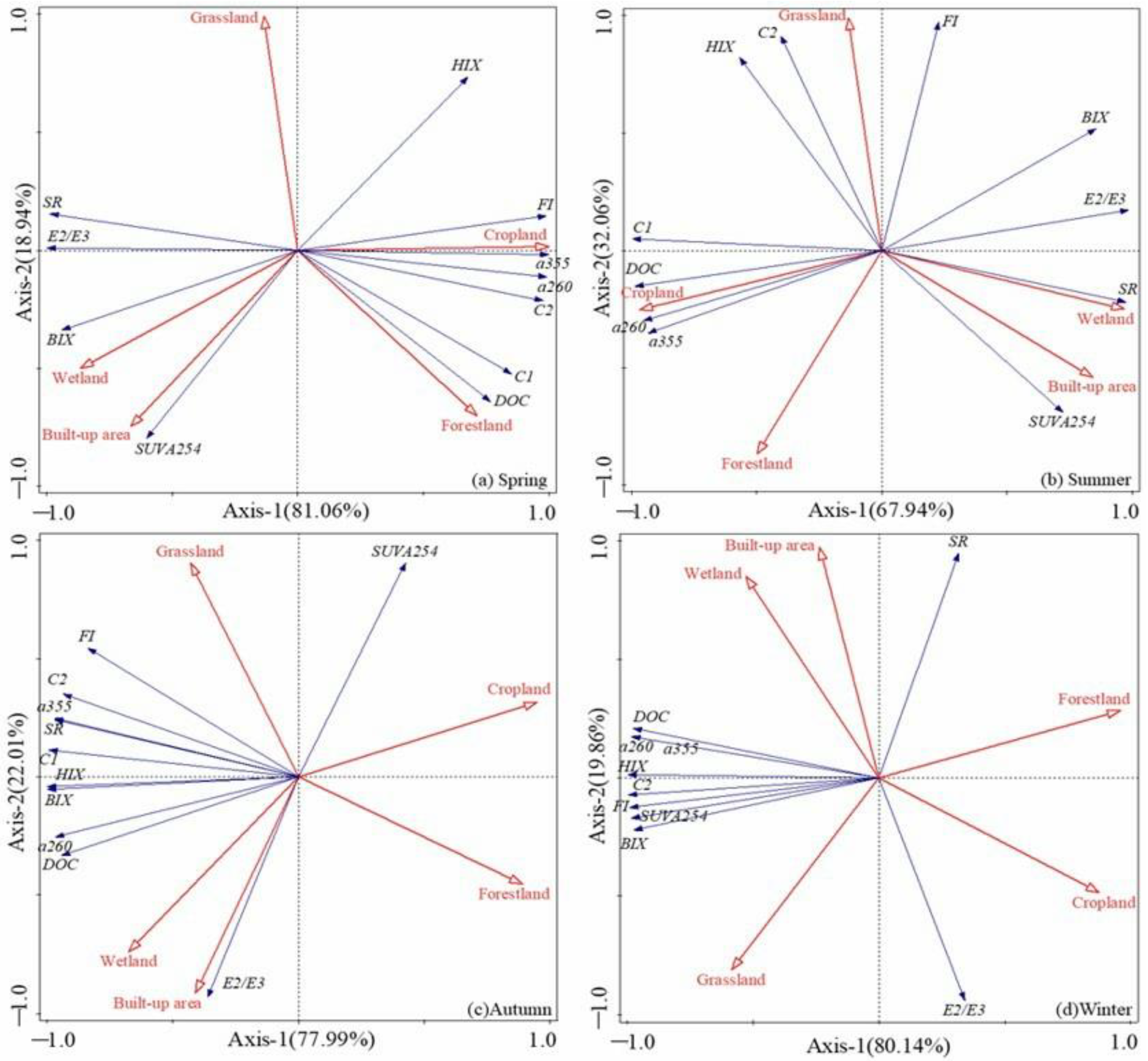
| Parameters | Units | Spring | Summer | Autumn | Winter | ||||
|---|---|---|---|---|---|---|---|---|---|
| H1–H12 | D1–D3 | H1–H12 | D1–D3 | H1–H12 | D1–D3 | H1–H12 | D1–D3 | ||
| pH | 8.56 ± 0.84 | 8.74 ± 0.33 | 8.33 ± 0.484 | 8.64 ± 0.35 | 8.44 ± 0.30 | 8.45 ± 0.35 | 8.16 ± 0.31 | 8.33 ± 0.01 | |
| T | °C | 15.03 ± 4.57 | 16.33 ± 4.87 | 28.27 ± 1.81 | 27.93 ± 1.35 | 16.24 ± 6.70 | 16.37 ± 7.68 | 4.48 ± 1.56 | 2.41 ± 0.74 |
| EC | ms·cm−1 | 2.30 ± 4.04 | 22.54 ± 22.40 | 1.77 ± 2.98 | 6.66 ± 14.65 | 1.20 ± 0.96 | 1.59 ± 0.74 | 1.81 ± 1.61 | 1.07 ± 0.29 |
| DO | mg·L−1 | 9.92 ± 1.81 | 9.85 ± 1.37 | 6.76 ± 3.08 | 7.78 ± 1.88 | 10.04 ± 3.07 | 9.88 ± 2.28 | 14.17 ± 2.45 | 14.01 ± 0.05 |
| Chl-a | μg·L−1 | 20.76 ± 23.58 | 27.90 ± 17.80 | 40.44 ± 49.48 | 34.98 ± 22.17 | 53.91 ± 47.99 | 34.53 ± 6.75 | 41.34 ± 78.37 | 18.59 ± 3.50 |
| Cl− | mg·L−1 | 435.01 ± 1128.04 | 2975.11 ± 6354.72 | 377.76 ± 942.44 | 2260.73 ± 5845.12 | 209.14 ± 321.58 | 271.21 ± 184.17 | 595.26 ± 694.18 | 220.87 ± 102.84 |
| NO3− | mg·L−1 | 0.58 ± 0.46 | 0.42 ± 0.49 | 0.78 ± 0.54 | 0.34 ± 0.25 | 1.66 ± 0.47 | 1.78 ± 0.90 | 1.53 ± 0.27 | 2.17 ± 0.11 |
| SO42− | mg·L−1 | 150.98 ± 225.49 | 538.14 ± 743.76 | 155.02 ± 185.52 | 454.289 ± 714.43 | 140.91 ± 80.63 | 225.14 ± 53.04 | 190.59 ± 127.07 | 188.80 ± 44.27 |
| HCO3− | mmol·L−1 | 3.03 ± 1.24 | 3.38 ± 1.38 | 2.88 ± 1.04 | 3.42 ± 0.57 | 3.53 ± 0.91 | 5.77 ± 4.60 | 3.68 ± 0.85 | 4.28 ± 0.26 |
| CO32− | mmol·L−1 | 0.06 ± 0.07 | 0.05 ± 0.03 | 0.06 ± 0.08 | 0.09 ± 0.05 | 0.05 ± 0.05 | 0.15 ± 0.34 | 0.02 ± 0.02 | 0.02 ± 0.00 |
| Na+ | mg·L−1 | 286.27 ± 646.49 | 1697.97 ± 3358.61 | 265.47 ± 594.97 | 1344.90 ± 3258.86 | 156.53 ± 198.58 | 208.12 ± 112.91 | 385.90 ± 415.47 | 176.10 ± 70.52 |
| K+ | mg·L−1 | 20.74 ± 47.54 | 57.29 ± 116.48 | 19.06 ± 45.29 | 50.76 ± 113.04 | 9.25 ± 8.09 | 8.95 ± 3.10 | 16.39 ± 15.22 | 8.08 ± 1.84 |
| Mg2+ | mg·L−1 | 45.47 ± 75.81 | 257.14 ± 437.22 | 44.93 ± 69.68 | 192.98 ± 419.24 | 39.50 ± 28.77 | 58.18 ± 15.56 | 68.51 ± 56.17 | 51.06 ± 12.20 |
| Ca2+ | mg·L−1 | 52.30 ± 38.50 | 127.30 ± 141.67 | 62.57 ± 29.37 | 119.29 ± 145.65 | 77.02 ± 32.69 | 99.40 ± 11.88 | 91.21 ± 30.01 | 98.51 ± 8.52 |
| Components | Exmax/Emmax | Description and Source | References |
|---|---|---|---|
| C1 | 250(290)/440; 255/412;225/449 | Terrestrial and marine humic-like materials | C1: <250(310)/416 [36]; C1: <250/448 [35]; Peak A: 230–260/380–460, Peak C: 290–310/370–420 [4] |
| C2 | 230(280)/345; 225(275)/344 | tryptophan-like | C2: 220(285)/348 [34]; C4: <250/350 [16]; Peak T: 225–230(275)/340–350 [4]; |
| C3 | 225(260)/301 225(265)/325; | Autochthonous tyrosine-like | C4: 230(270)/306 [37]; C8: 275/304 [35]; C3: 220(270)300 [34]; |
Disclaimer/Publisher’s Note: The statements, opinions and data contained in all publications are solely those of the individual author(s) and contributor(s) and not of MDPI and/or the editor(s). MDPI and/or the editor(s) disclaim responsibility for any injury to people or property resulting from any ideas, methods, instructions or products referred to in the content. |
© 2023 by the authors. Licensee MDPI, Basel, Switzerland. This article is an open access article distributed under the terms and conditions of the Creative Commons Attribution (CC BY) license (https://creativecommons.org/licenses/by/4.0/).
Share and Cite
Chen, Z.; Wen, Y.; Xiao, M.; Yue, F.; Zhang, W. Characteristics of Dissolved Organic Matter Impacted by Different Land Use in Haihe River Watershed, China. Int. J. Environ. Res. Public Health 2023, 20, 2432. https://doi.org/10.3390/ijerph20032432
Chen Z, Wen Y, Xiao M, Yue F, Zhang W. Characteristics of Dissolved Organic Matter Impacted by Different Land Use in Haihe River Watershed, China. International Journal of Environmental Research and Public Health. 2023; 20(3):2432. https://doi.org/10.3390/ijerph20032432
Chicago/Turabian StyleChen, Zhaochuan, Yanan Wen, Min Xiao, Fujun Yue, and Wenxi Zhang. 2023. "Characteristics of Dissolved Organic Matter Impacted by Different Land Use in Haihe River Watershed, China" International Journal of Environmental Research and Public Health 20, no. 3: 2432. https://doi.org/10.3390/ijerph20032432
APA StyleChen, Z., Wen, Y., Xiao, M., Yue, F., & Zhang, W. (2023). Characteristics of Dissolved Organic Matter Impacted by Different Land Use in Haihe River Watershed, China. International Journal of Environmental Research and Public Health, 20(3), 2432. https://doi.org/10.3390/ijerph20032432







